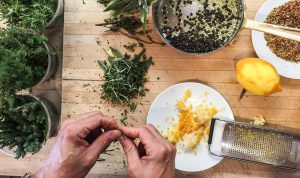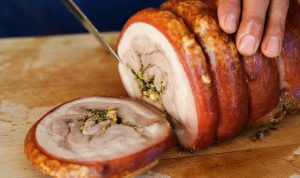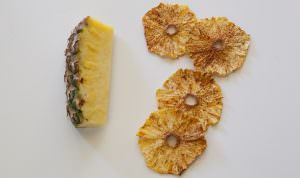Guide to Making A Dry Rub Video Recipe for Three Exotic Spice Rubs
Create three flavorful spice rub recipes from one simple base
We are fortunate in Sonoma wine country to be able to fire up the terrace grill almost year-round, but summer is still the season when we grill the most–and stock up on my favorite, ethnic dry rub blends to get us through the season.
In this video, I demonstrate how to make the Jordan Winery dry rub recipe base, which can last all summer and into fall, and most importantly, be quickly and easily adapted into an Asian, Mediterranean or Indian dry rub with a few exotic spice additions. You get three different dry rubs with one simple base. (You can also use the base rub on its own.) I prefer pairing each ethnic spice rub with a meat typical of that culture, such as pork shoulder or duck for the Asian spice rub, lamb for the Mediterranean and chicken for the Indian spices, but there are no rules. Experimenting with different meats, as well as baking–not just grilling, will help you create an array of delicious main courses from the same dry rubs, each highlighting different flavors. Dry rubs don’t need to be relegated to backyard grills. They’re great for meats slow roasted in the oven during winter months, too.
When selecting a dry rub recipe for a meat, be mindful of your wine pairing. If you’ll be serving Cabernet Sauvignon, I recommend staying away from hot curries and using a sweet curry spice, as the heat will over-accentuate the alcohol in the wine. This topic is covered in the above video, but feel free to ask any questions about wine pairings in the comments.
I always recommend using whole spices and grinding them in a spice grinder, as the flavors will be fresh and bright. Here’s a great blog post about how to grind your own spices. That said, Penzeys, my favorite spice purveyor, is an excellent source for whole and pre-ground spices. When using pre-ground spices, you can simply skip the grinding step noted in all four recipes below.
To learn how to prepare a pork shoulder for this dry rub recipe, watch my recent demonstration video.
Recipe: Jordan Winery Dry Rub Base
Ingredients ~
- 2 cups kosher salt
- 1 cup granulated sugar
- ½ cup Demerara sugar
- ½ cup black peppercorns
- 3 T ground garlic
- 2 T Colman’s mustard
- 4 T dried onion
Instructions ~
- Grind whole spices together with a spice grinder or mortar and pestle (if using whole spices vs ground).
- Mix with a whisk in a non-reactive bowl.
- Store in a mason jar in a cool, dark place. Allow flavors to meld for 48 hours before use.
- Will keep for 2-3 months.
Preparation time: 15 minute(s)
Yield: 5 cups (80 servings; enough for 40 pounds of meat)
Recipe: Asian Dry Rub
Ingredients ~
- 1 T fermented black beans
- 1 T tangerine peel
- 1 T Chinese 5 spice powder *
- ½ T Sichuan peppercorn
- ½ T ground ginger (galangal may be substituted)
- 2 chile piquins
- 1 ¼ cup base rub
*Note: If you can’t find all of the above Asian ingredients, simply substitute 4 T of Chinese 5 spice powder and mix it with 1 ¼ cup base rub.
Instructions ~
- Finely chop fermented black beans.
- Grind all whole spices, including the chopped fermented black beans, together with a spice grinder or mortar and pestle (if using whole spices vs. ground).
- Add freshly ground spices into non-reactive bowl with 1 ¼ cup base rub and fermented black beans. Mix with a whisk.
- Store in a mason jar in a cool, dark place. Allow flavors to meld for 48 hours before use.
- Will keep for 2-3 months.
Preparation time: 15 minute(s)
Yield: 1 ¾ cups (16 servings; enough for 8 pounds of meat)
Recipe: Mediterranean Dry Rub
Ingredients ~
- 1 T oregano
- ½ T marjoram
- ½ T cumin
- ½ T sumac berry
- ½ T dried lemon peel
- ½ T Aleppo pepper
- 1 T smoked Spanish paprika
- +1 ¼ cup base rub
Instructions ~
- Grind whole spices together with a spice grinder or mortar and pestle (if using whole spices vs. ground).
- Mix with a whisk in a non-reactive bowl with 1 ¼ cup base rub.
- Store in a mason jar in a cool, dark place. Allow flavors to meld for 48 hours before use.
- Will keep for 2-3 months.
Preparation time: 15 minute(s)
Yield: 1 ¾ cups (16 servings; enough for 8 pounds of meat)
Recipe: Indian Spice Rub
Ingredients ~ *
- 3 tsp. cumin
- 2 tsp. coriander
- 2 tsp. fennel pollen
- 2 tsp. turmeric
- 2 tsp. ground ginger
- 2 cardamom pods
- 1 ¼ cup base rub
*Note: If you can’t find all of the above ingredients, simply substitute 4 T of Maharajah curry powder and mix it with 1 ¼ cup base rub.
Instructions ~
- Grind whole spices together with a spice grinder or mortar and pestle (if using whole spices vs. ground).
- Mix with a whisk in a non-reactive bowl with 1 ¼ cup base rub.
- Store in a mason jar in a cool, dark place. Allow flavors to meld for 48 hours before use.
- Will keep for 2-3 months.
Preparation time: 15 minute(s)
Yield: 1 ¾ cups (16 servings; enough for 8 pounds of meat)
Video Transcript
Today we’re going to talk about summer dry rubs, how to start with a base of the last few throughout the summer, and then three ethnic blends off of the base. We’ll do an Asian and Indian in the Mediterranean rub.
Today we will begin with our base rub. This rub should get you throughout the summer, if stored properly in a cool dark place. The total recipe will create about five cups of dry rub. Five cups of the dry rub will be enough for 80 portions or 40 pounds of meat. Because of the size of the recipes and the quantity that we’re talking about here, this is for illustrative purposes only.
For a recipe, we’ll begin with two cups of kosher salt. I prefer to use kosher salt because it is clean, easy to measure. For the sugar component I use two types, I use ground white granulated sugar and they use demerara sugar, one cup of the white one-half cup of the demerara raw sugar. I’m getting flavor out of those molasses components and notes. One half cup black peppercorns, freshly ground, I prefer Indian black peppercorns Tellicherry. This is extra bold from penzeys spices. Your pepper should never be used on the ground. Notice that this is extremely black and not gray. Three tablespoons of ground garlic, three tablespoons of Colman’s mustard, good neutral mustard, not too much heat, we want to watch the heat across all of our spice rubs as we’re pairing with one. Four tablespoons of dried onion. Again, this is from penzeys. I’d hydrate my own but penzeys have a great onion flavor. There are some poor examples but if you go with penzeys you can’t go wrong. If for your dry rub you’re using whole spices which I recommend. Then simply add them all together in a spice grinder and then mix in a nonreactive bowl. If beginning with ground spices, simply place them in the nonreactive bowl and use a whisk or your fingers and blend them together. This is the premade base rub. I recommend using a mason jar. They’re easily reusable. They seal tightly with a rubber gasket stored in a cool dark place. And this will last for two to three months.
Now we will begin with our base and we will make an Asian rub. These are Asian ingredients we have one tablespoon of fermented black bean, one tablespoon of tangerine peel, one tablespoon of Chinese five-spice powder, a half a tablespoon of Sichuan peppercorns, one-half tablespoon of ground ginger or galangal if available, and to each of Chile piquín. The Chinese black beans they’re fermented they’re available in most ethnic groceries. I finally chopped them. This is one ingredient they can’t go in your spice grinder. This is going to add umami. That soy sauce with six tastes within dry ingredients is the closest I’ve come to it. The dried tangerine peel is very classical Chinese and Southeast Asian cooking. The Chinese five-spice powder also contains garlic, the Sichuan peppers, some licorice, and they’re actually probably eight or nine spices and Chinese five-spice powder. The Sichuan is actually not a peppercorn but there’s a berry and there’s nothing quite like it. It has a numbing agent and it’s very identifiable to Chinese food. Galangal will have a piney resinous taste which is Southeast Asian or Chinese dried ginger. And then chili piquín is also used in Latin cooking but is used in Chinese cooking as well. Most of these items may be found in a ground form in an Asian market with the exception of the fermented black bean which must be chopped by hand. If you’re in a pinch, I would recommend substituting four tablespoons of the Chinese Five Spice for our base one. I prefer this rub with pork, a rib dry rub finishing with a wet mop and it’s excellent with duck which is also a game pairing which is fabulous with the Cabernet Sauvignon.
Now that our black beans have been cut by hand, all of the ingredients can be added to the spice grinder at once, and then ground to a fine powder. Once the spice has been ground blended with a one and a quarter cup of the base, then it can be stored just as we did our base. I would however if at all possible allow the flavors to blend and meld in the base itself for 48 hours before using it for the first time.
The next plan I’ll show you is our Mediterranean blend and to our one and a quarter cup base we will add one tablespoon of oregano, half a tablespoon of marjoram, half tablespoon of cumin, a half tablespoon of sumac Berry, a half tablespoon of dried lemon peel, a half tablespoon of Aleppo pepper, and one tablespoon of smoked Spanish paprika. When designing these ethnic blends, it’s a rather broad mingling of all the different cultures. We have Turkish oregano, we have marjoram from Greece. I have sumac berries again from Turkey. The sumac allows us to incorporate a brightness and a red berry flavor into the rub without the addition of acids which would compete with the shard near Cabernet. Whole cumin if available toast and then ground. The Turkish Aleppo pepper is a sweet roasted pepper that imparts very little heat, and the smoked Spanish paprika comes from the Basque region. These are smoked over open fires and there’s nothing else like it and I really think that captures the Mediterranean and makes it a distinctive rub, but the procedure for finishing our BLEND is the same as the Asian, all of these ingredients which would equal approximately four tablespoons are added to our one and a quarter cups of the base blend. Now for our final rub, we will do our Indian rub.
To our base, we will add three teaspoons of cumin. I recommend using whole cumin toasting, two teaspoons of coriander, whole coriander again very fleeting with essential oils toasted right in advance, two teaspoons of fennel pollen to get that great anise flavor that works well with a Cabernet. Two teaspoons of turmeric is a substitute for saffron that’s gonna bring us a bright color in a very distinct and unique flavor. Two teaspoons of ground ginger these are the cardamom pods this is readily available on most baking sections ground but if you can find the pods again toast and grind and if you don’t have the time or cannot locate any of these whole ingredients I recommend and this is from penzeys as well this is their Maharaja curry paste is very mild in heat but it is the best peppers the best saffron from Kashmir available. This is an excellent substitute and all-around curry powder to pair with one. I recommend when pairing with wine to use a mild curry where this is very low in heat and heat will bring out the alcohol and wine it doesn’t pair well. This would be considered a medium to sweet curry. Once you have this in your clipboard, it’s easy to grab whatever proteins are available, whatever someone brings over potluck, put your own spin on it, and then either grill it slowly, cook it using whatever cooking preparation you’re using that day. But you’re one step ahead and you’re customizing that meal.




Hi, I was curious if you recommend a certain brand or could help to specify the fermented black beans. I’d like to make sure I buy the correct ones. Thanks.
Pingback: Info | Teach Us Wine
Pingback: Indian Recipes for Everyone To Try!